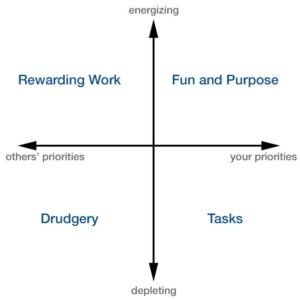Bryley Basics: What is a True Work-Life Balance and how is it Achieved?
When one mentions the phrase “work-life balance” many think of it in terms of juggling. A better analogy is that of a surfer – it is dynamic, all the variables are “inter-related and trade off among each other.”1 Stew Friedman put it best in his article for Harvard Business Review, The idea that ‘work’ competes with ‘life’ ignores that ‘life’ is actually the intersection and interaction of four major domains: work, home, community, and the private self.”2
Here are some suggestions on how to achieve a work-life balance that fits for you.
- Balance does not mean equal, and it shouldn’t “Work” and “life” are not static, they ebb and flow just like anything else. As a result, one may find they have to shift priorities of the day, week, month, or even year. That’s simply part of living a full life. If you have a big meeting, chances are you will stay later at the office than usual, and you may find yourself leaving early some days due to family events (school play, family doctor’s appointments, etc.). It’s all about evaluating your tasks and prioritizing them according to your values.
- You don’t need to overbook your days Many individuals believe that in order to have balance in their life, they need to accomplish more in less time. This can often create stress and mistakes by rushing to complete tasks. The secret to getting more done is actually to slow down and focus on one project at a time, thereby avoiding silly mistakes or errors. This will necessitate a need to evaluate your priorities. Dan Thurman gave a Tedx Talk explaining this: “It’s not about increasing your pace, because life speeds right up with you. Ironically, by slowing down even a little, you begin to notice those spaces, those opportunities, and they expand for you.”3 Slowing down enables you to fully immerse in a given activity, be it personal or professional, and grant it the attention it deserves. Oftentimes, in doing this type of evaluation, you will find many activities that can either be delegated or may not be necessary anymore, thus giving you more time to pursue other opportunities.
- Happiness comes from Career and Achievement Happiness comes from achievement, but it should not be the sole source of happiness. It is important to derive happiness from the position as well as the achievements. Lauren Bacon’s Balance Matrix describes the key to feeling happiness while completing tasks and how it can contribute to work-life balance.4 Keep this chart in mind can help you change your perspective to gain a sense of happiness.

It is important to remember that we, as individuals, have the opportunity to shape our life and the “work-life balance.” It is shaped every day in the decisions we make.
- Venkatesh Rao. Work-Life Balance: Juggling, Spinning or Surfing? September 2007.
- Stew Friedman. What Successful Work and Life Integration Looks Like. October 2014.
- Dan Thurmon. Off Balance on Purpose: The Future of Engagement and Work-Life Balance. 2013
- Lauren Bacon. ‘The Balance Matrix: My Answer to the “Work-Life Balance’ Question’ Jan 2014







